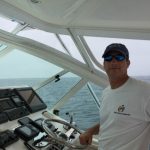Cummins Marine Diesel Repower Specialists › Forums › Cummins Marine Engines › Locked Turbo on low time QSB 6.7
- This topic has 28 replies, 4 voices, and was last updated 5 years ago by
bdunigan.
-
CreatorTopic
-
August 21, 2018 at 11:15 am #36251
bduniganParticipantI bought a Sabre 42 in March 18 that had its port turbo replaced the prior June 17. This boat is a 2013 with Cummins QSB 6.7 380hp units tied to Zeus 3000 pods. 323 hours now. 272 hours at time of purchase. 237 hours at time of turbo replacement. I just received a copy of the repair invoice which reads as follows:
…Port engine has lack of power. Noted excessive oil from the after cooler condensation valve, removed the Air Sep element and inspected the turbocharger – locked up…
The technician proceeded to replace the failed unit with a factory reman turbo. I have checked the part numbers with Cummins and the correct unit was used (though I would have preferred a new unit).
My first question is ‘what could cause this turbo to fail so early in its service life’? Where did the oil in the AC condensation valve come from? Does the oil and the turbo failure indicate any other causal issues? Service records are acceptable on this boat with annual oil services done as expected.
At this time, the port engine does not quite develop full power. (Starboard engine does.) Cummins calls for 3000rpm WOT and Sabre test numbers call for 3050rpm WOT. The port engine achieves 2920rpm at WOT. Interestingly, at 2300 rpm, the port engine turbo boost is 14.5 pounds while the starboard engine turbo boost is 12.9 pounds. At WOT, the port engine turbo boost is 24.5 pounds while the starboard engine boost is 27.5 pounds. Is this significant? Does this indicate further issues?
Props are stock units from Sabre…Z15/Z14 dual Zeus pods props.
-
CreatorTopic
-
AuthorReplies
-
September 9, 2018 at 7:14 pm #36950
bduniganParticipantTony, take a look at the pics in my posts on August 22 along with some others posted here from the same photo session. Let me know if you find these insufficient for your review. As usual, there isn’t a ton of room around the exhaust but I can certainly take more.
As previously mentioned, Phil requested I remove the exhaust elbow and take shots of the exhaust side of the turbo. I haven’t been able to do that yet.
Many thanks.
September 9, 2018 at 6:18 pm #36948
Tony AthensModeratorVessel Name: Local Banks
Engines: QSB 6.7 550 HP
Location: Oxnard, CA
Country: USA
POST very good pictures of your exhaust showing all–All angles & all perspectives.. Need to see all..
HURRY!
Tony
September 9, 2018 at 1:47 pm #36934
bduniganParticipantTony,
Thanks for responding and for all you do to help us folks.
My original posts expressed my concern about the prematurely locked turbo and the port engine failure to hit its numbers at WOT. I ran the no load test to confirm the engine would hit 3050 (which it did) to eliminate mechanical issues from the equation (tachometer inaccuracies, throttle calibration, etc). Now I will focus on load variables.
Re the turbo: I owe Phil some pics which are coming soon. Phil has been a terrific help. In the meantime, I determined the exhaust elbow was built by DeAngelo and has an inner section (exhaust) and an over section (wet). DeAngelo asserts that back flow into the turbo is eliminated with this design. (Don’t shoot the messenger.) My surveyor feels that either the turbo was defective or the former owner backed the boat down hard from a high cruise and water backflowed that way.
September 9, 2018 at 1:13 pm #36933
Tony AthensModeratorVessel Name: Local Banks
Engines: QSB 6.7 550 HP
Location: Oxnard, CA
Country: USA
What am I missing here? What are you not asking why the engines needed new turbos at such low hours? That is where this thread should be going..
For sure, they are not wearing out or were they defective when new—For sure, it is installation related.
Don’t just fix the result of the issue–You have to fix the “Why did it happen first”…
Tony
September 8, 2018 at 2:10 pm #36910
bduniganParticipantWell, I did learn something today. I ran a throttle only WOT test on the port engine and it ran right up to 3050rpm. This tells me my issue is with the props. Having the boat hauled in a week and will take it from there.
August 27, 2018 at 11:23 am #36454
PhilipParticipantVessel Name: 2007 35’ Cabo ‘FUGA’
Engines: Cummins QSC8.3-540’s
Location: Long Beach, CA
Blue… happy to help.
Keep us posted, and look forward to pictures.
Phil
August 27, 2018 at 5:44 am #36447
bduniganParticipantAs additional history on this boat, the previous owner lost a port prop blade last summer (along with the turbo replacement). He ended up replacing the unit with a ‘demo’ blade removed from another boat. The replacement blade is the exact match for the original according to the part number stamped on the blade/ However, I consider the story a bit suspect. He said he couldn’t locate a ‘new’ blade. In fact, they are readily available.
At this point, I still owe you a pic of the turbo which I will have hopefully this week.
I am dealing with four props, not one or two. They are counter-rotating and different sizes on each pod gear unit. It might be a bit trickier to underprop this pod boat. I saw a topic where an owner was underpropping a Sabre 48 and hope he will have some info on how that went.
Phil, thanks for your time and expertise. You are clearly correct about the causes of and solutions to my issues.
August 25, 2018 at 3:59 pm #36410
PhilipParticipantVessel Name: 2007 35’ Cabo ‘FUGA’
Engines: Cummins QSC8.3-540’s
Location: Long Beach, CA
When you go to the prop shop and they scan the props pre work I will bet dollars to doughnuts that one props effective pitch is more than the other accounting for the difference.
Don’t use Sabre data, use Cummins data.
As for throttle rigging it’s all electronic on the Q’s so nothing there.
A prop pitch change will reduce your fuel burn and increase your max rpm all at once.
Keep in mind I guarantee your boat will only get heavier than your testing so don’t be afraid to reduce your prop pitch aggressively if you truly want to do the best for your engines.
Phil
August 25, 2018 at 8:03 am #36405
bduniganParticipantHere is the QSB 6.7 HO data sheet. The CPL doesn’t match but the Engine Configuration number does. I couldn’t find the data sheet for the CPL3164 unit. I guess CPL is ‘critical parts list’. Don’t know how important it is.
August 25, 2018 at 6:52 am #36404
bduniganParticipantWow, I charted and compared my numbers to Sabre’s and there is no question I burn more fuel than their test numbers. The reasons are obvious and have been stated on this forum many times over. So it looks like ‘off to the prop shop I go’.
Still need to figure out I the port engine WOT deficiency is caused by the prop issue of the turbo/wet exhaust/other possible causes.
August 25, 2018 at 6:04 am #36402
bduniganParticipantDisregard the early bird comment… Your reply appeared on my system at 2:23 and I added 3 hours instead of subtracted. Gotta wonder…
August 25, 2018 at 5:56 am #36401
bduniganParticipantAn early bird I see! Hope you are going boating today!
Sorry to have omitted engine data. Here it is…
Port engine: 73432746
Stbd engine: 73432781
QSB 6.7 380hp HOP (high output) QSB 6.7 M CM2250 CPL3164With this info, does your posted Performance chart work or is there one for this CPL number (HOP engine)?
Hope to shoot pics of the turbo this week.
Just a thought but aside from the focus on the props, fuel burn, and load, could the fact that the port engine fails to reach 3000 at WOT simply be related to the replacement turbo install? How do I make sure the technician properly reinstalled the throttle cabling and settings? The two engines seem to parallel each other right up to WOT. Then the port engine falls behind in both rpm and turbo boost. Call me crazy…
August 24, 2018 at 11:23 pm #36398
PhilipParticipantVessel Name: 2007 35’ Cabo ‘FUGA’
Engines: Cummins QSC8.3-540’s
Location: Long Beach, CA
Nice chart!
I don’t have your engine serial/cpl numbers to compare but assuming your cpl is 4191 I am posting a link to the fuel burn curve. If you take a moment to compare your rpm/fuel burn numbers you will see your burning more fuel than Cummins spec at all rpms which means your engine is working too hard. Also your engine simply can not get enough fuel into the engine to get to max rpms. You need to reduce prop pitch,
Comparing the Sabre fuel burn to rpm to Cummins spec Sabre some how thinks the engines can work harder than Cummins designed….I don’t get that.
Bottom line you now can take this info with your props to the shop and tell them you need to be propped to achieve 3075+++ rpm and under the fuel burn curve. They should be able to figure out how mipich pitch to remove from the prop.
The data doesn’t change with tide or current as the engine doesn’t care. The boat speed over ground might change but the effort to turn the prop is the same.
Phil
August 24, 2018 at 6:11 pm #36394
bduniganParticipantPERF NUMBERS
PHIL:
The previous performance file was missing the performance numbers at 2600 rpm. This file has those numbers. My bad.
August 24, 2018 at 5:50 pm #36391
bduniganParticipantPerformance Numbers
Phil:
Performance numbers are in. Be forewarned that they were not done scientifically by running back and forth along a track in order to negate tide. These were taken during a one way run from west to east in the Chesapeake. The conditions were: 90% fuel, 90% water, 0% holding, 4 souls on board, temp 77, waves > 1 foot (real smooth).
I have attached two files. The first is the Sabre 42 performance graph for the QSB 6.7. The second is my data. I am not qualified to discuss performance the way you and Tony do and am still trying to learn your language.
Take a look at these numbers and tell me if you see anything or if you need more info. I will tell you that at WOT the port engine only achieves 2920 RPM (24.9 turbo boost) while the starboard achieves 3000 (not the 3050 Sabre shows). From 1400-2400 RPM, the port turbo boost runs ahead of the starboard. However, the differences are fairly small.
August 24, 2018 at 5:40 pm #36390
bduniganParticipantRob:
Thanks for this excellent advise. I hope to get a solid pic off the exhaust side of the turbo next week.
August 23, 2018 at 6:11 pm #36367
Rob SchepisForum ModeratorVessel Name: Tenacious
Engines: 6BTA 5.9 330's - "Seaboard Style"
Location: Long Island, NY
Country: USA
If you’re pulling the wet exhaust apart do be mindful of securing it good and high, don’t want it to hang low or fall down when you’re not present and flood the engine room… This is not based on my observing or identifying your actual LWL, just a general thing to be mindful of when doing this type of work when she’s afloat.
August 22, 2018 at 6:48 pm #36340
PhilipParticipantVessel Name: 2007 35’ Cabo ‘FUGA’
Engines: Cummins QSC8.3-540’s
Location: Long Beach, CA
Blue
The rust I see in #887 is the waste gate cover not the exhaust elbow. This area gets very hot and not uncommon to see paint gone and some scalling.
Warranty of the reman unit? Keep in mind the reman unit won’t fail due to a defect in the turbo rather it will fail because the exhaust is the cause. Even if there is existing warranty left it wouldn’t cover a failure caused by external factors.
Get the exhaust elbow off and let’s SEE the exhaust side of the turbo. It’s not hard. Couple of hose clamps at the bottom, the support strut, two hose clamps that supply cooling water at the top, and 4 bolts at the top that connect the exhaust to the turbo. You can get the whole exhaust out of the way and take some good pictures. Then just reinstall all, put some good anti seize on the 4 top bolts when reassembling.
This will tell us definitively next steps…
Phil
August 22, 2018 at 6:31 pm #36333
bduniganParticipantPhil:
I agree. It was pretty obvious when I looked closely at the exhaust/heat exchanger hose set up that water could be getting to the turbo. If you look at picture #885, there is no rise/fall in the exhaust pipe and the HE hose is connected on or near the same plane or level is the turbo. If you look at pic#887, there is external rust. Perhaps this is normal but there is a source of water in the area.
I am talking to the tech who replaced the turbo to get his thoughts. Wonder if there is a warranty of the reman unit??
Performance numbers to follow Friday night.
August 22, 2018 at 6:03 pm #36331
PhilipParticipantVessel Name: 2007 35’ Cabo ‘FUGA’
Engines: Cummins QSC8.3-540’s
Location: Long Beach, CA
Thanks for the pictures. Looks like a clean install and nice engine room. Hard to tell angles and waterline locations from the photos but I suspect you have something going on with your exhaust elbow design causing the turbo failure and without further investigation and correction a future turbo failure. Almost always a failing turbo is a result of the turbo eating saltwater. This is usually caused by poor exhaust design and/or failing exhaust elbows. In your case the exhaust elbow could have been designed better by taking advantage of the few inches of height above the turbo (exiting turbo upwards, turning 180 downwards and then injecting water on the down side.
Although th exterior condition of the exhaust elbow looks good, I would recommend removing the elbow from the turbo and posting good pictures of the inside of the exhaust side of the turbo. It’s an easy remove exhaust elbow, photo just like in the article below and replace item. I suspect inside the turbo will be scaly and rusted. Read this article…
While you don’t have a failed turbo yet unless you find the cause of the turbo failure it will fail again. If your turbo is in fact eating saltwater it will save you in the long run to put the effort in now to correct. It might mean an exhaust redesign and rebuild but turbos every 250-300 hours will get expensive.
To summarize you have two issues most likely:
1. Overpropped
2. Something causing turbo to fail, most likely exhaust elbow.Phil
-
AuthorReplies
You must be logged in to reply to this topic.
